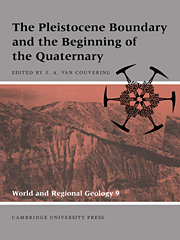Book contents
- Frontmatter
- Contents
- List of contributors
- Preface: the new Pleistocene
- Foreword
- Part I Definition of the base of the Quaternary
- Part II Characterization of the Pleistocene boundary-stratotype
- Part III The paleontological context of the Pleistocene boundary
- Part IV The Pleistocene boundary in regional sequences
- 11 The Pliocene–Pleistocene boundary in Italy
- 12 Stratigraphy of the Plio–Pleistocene sequence of the Mediterranean coastal belt of Israel and its implications for the evolution of the Nile Cone
- 13 The Pliocene–Pleistocene transition in the Iberian Peninsula
- 14 Biostratigraphy and calibrated climatic chronology of the Upper Pliocene and Lower Pleistocene of France
- 15 The Plio–Pleistocene of England and Iceland
- 16 The Neogene–Ouaternary boundary in The Netherlands
- 17 The Tertiary–Quaternary boundary in western Germany
- 18 The Pliocene–Pleistocene boundary in eastern Germany
- 19 The Plio–Pleistocene of Hungary
- 20 The Pliocene–Pleistocene boundary in Romania
- 21 The Pliocene and Pleistocene of the European part of the Commonwealth of Independent States
- 22 The N/Q boundary in Asian Russia and Tadjikistan
- 23 The Pliocene–Pleistocene boundary in the Indian subcontinent
- 24 The Pliocene–Pleistocene boundary in Japan: the Osaka Group, Kinki district
- 25 The Pliocene–Pleistocene boundary in Japan: stratigraphy in the Boso Peninsula, central Japan
- 26 The base of the Quaternary in China
- 27 Plio–Pleistocene deposits and the Quaternary boundary in sub-Saharan Africa
- 28 Plio–Pleistocene reference sections in Indonesia
- 29 The Pliocene–Pleistocene boundary in New Zealand
- 30 The Pliocene–Pleistocene boundary in continental sequences of North America
- Index
22 - The N/Q boundary in Asian Russia and Tadjikistan
Published online by Cambridge University Press: 10 November 2009
- Frontmatter
- Contents
- List of contributors
- Preface: the new Pleistocene
- Foreword
- Part I Definition of the base of the Quaternary
- Part II Characterization of the Pleistocene boundary-stratotype
- Part III The paleontological context of the Pleistocene boundary
- Part IV The Pleistocene boundary in regional sequences
- 11 The Pliocene–Pleistocene boundary in Italy
- 12 Stratigraphy of the Plio–Pleistocene sequence of the Mediterranean coastal belt of Israel and its implications for the evolution of the Nile Cone
- 13 The Pliocene–Pleistocene transition in the Iberian Peninsula
- 14 Biostratigraphy and calibrated climatic chronology of the Upper Pliocene and Lower Pleistocene of France
- 15 The Plio–Pleistocene of England and Iceland
- 16 The Neogene–Ouaternary boundary in The Netherlands
- 17 The Tertiary–Quaternary boundary in western Germany
- 18 The Pliocene–Pleistocene boundary in eastern Germany
- 19 The Plio–Pleistocene of Hungary
- 20 The Pliocene–Pleistocene boundary in Romania
- 21 The Pliocene and Pleistocene of the European part of the Commonwealth of Independent States
- 22 The N/Q boundary in Asian Russia and Tadjikistan
- 23 The Pliocene–Pleistocene boundary in the Indian subcontinent
- 24 The Pliocene–Pleistocene boundary in Japan: the Osaka Group, Kinki district
- 25 The Pliocene–Pleistocene boundary in Japan: stratigraphy in the Boso Peninsula, central Japan
- 26 The base of the Quaternary in China
- 27 Plio–Pleistocene deposits and the Quaternary boundary in sub-Saharan Africa
- 28 Plio–Pleistocene reference sections in Indonesia
- 29 The Pliocene–Pleistocene boundary in New Zealand
- 30 The Pliocene–Pleistocene boundary in continental sequences of North America
- Index
Summary
Introduction
On the Siberian Platform (i.e., the region extending from the Urals eastward to the Pacific Ocean), biostratigraphic, radiometric, and paleomagnetic scales have been applied to Pliocene and Pleistocene deposits to correlate them not only with the stratotype sequence of Vrica but also with key sequences of the European part of the former USSR and in Europe.
Stratigraphic summary
Nine areas are particularly helpful in studying the Plio–Pleistocene succession of this region. These are western Siberia, Transbaikalia, Olkhon Island in Lake Baikal, the upper basin of the Lena River, central Yakutia, the Kolyma Basin, Kamchatka, and the Primorie/Priamurie region (i.e., the Pacific coast provinces), all in eastern Russia, and the Tadjik Depression of Tadjikistan (Figures 22.1 and 22.2). There are difficulties, however, including the unequal extent of exploration, inadequate exposures, and the vast area of territory in Siberia affected by permafrost. As a result, few sequences are adequately known.
Western Siberia
The Plio–Pleistocene deposits of southwestern Siberia, around the headwaters of the Ob River, can be considered of paramount importance, as they include faunistic complexes that support extensive biostratigraphic correlations. The Kochkov Formation, which covers the Upper Pliocene and Eopleistocene, from about 2.4 Ma to 0.6 Ma, contains a series of sediments with four faunal complexes (Figure 22.2). The layers of Betekian age at the base contain remains of Hipparion sp., Paracamelus gigas, Paracamelus praebactrianus, Trogontherium minor, Promimomys gracilis, Mimomys polonicus, Mimomys hintoni, Villanyia petenyii, Villanyia steklovi, and so on (Zazhigin, 1980).
- Type
- Chapter
- Information
- The Pleistocene Boundary and the Beginning of the Quaternary , pp. 227 - 231Publisher: Cambridge University PressPrint publication year: 1996



